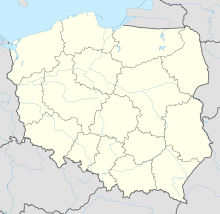Slavic and Viking settlement Wolin
Slavic and Viking settlement Wolin is an archaeological open-air museum in Wolin , sponsored by the association Center for Slavs and Vikings "Wolin-Jomsborg-Vineta" ( Polish Centrum Słowian i Wikingów "Wolin-Jomsborg-Wineta" ). The facilities of experimental archeology include the early medieval Slav and Viking settlement of Wolin and an information center in front of the village. An essential part of the museum concept is based on the most authentic possible representation of life at that time by employees and association members.
Slavic and Viking settlement Wolin
The early medieval Slavic museum village Slavs and Vikings settlement Wolin is located 700 meters east of Wolin, on the Plageinsel on the Dievenow , to be reached via the city bridge from Wolin to Recław (Hagen) and from there over the small bridge to the Plageinsel. According to archaeological findings, Slavic log , post and split-timber houses from the 9th and 10th centuries were reconstructed in their original size . Surrounded on the land side by a wooden palisade is located to the river, a quay by the archaeological findings of the historic ship "Eagle Jumna" (construction to 900/1100). The ship was built according to plans of the " Ukranenlandes Torgelow". The quay and harbor were reconstructed according to the plans of the Szczecin museologist Władysław Filipowiak .
The settlement consists of 27 huts, 4 gates, the enclosing wall with added palisades and the port with quay.
Permanent employees in historical costumes are present in the museum village . Each employee has mastered historical craft , including bronze foundry , potters and blacksmiths .
During the season and especially during the festival, the club members and special guests from outside live and work in the huts.
Looking, touching, trying out and doing it yourself is an essential part of the educational concept. Other crafts are u. a. Braiding , felting , weaving , carving , baking and leather processing . Musicians operate various historical instruments or demonstrate how they are made.
Special highlights are the Viking Festivals, which take place annually on the first weekend in August with 1,500 participants from 24 countries.
The facilities of the open air museum are open from the beginning of April to the end of October.
Networks
The Slav and Viking settlement Wolin is part of the transnational cooperation "Baltic History", which is dedicated to the tangible early medieval history of the Baltic Sea region. The cooperation includes the Viking reserve Foteviken (Sweden) and the Ukranenland Torgelow. It is also part of the “Lagomar Project”, which deals with the natural and cultural heritage in the southern Baltic Sea region.
history
After the excavations in 1992, the idea of building historical workshops arose. The first Viking Festival followed in 1993 and the association was founded in 2001. Then the Slavic village on the Dievenow was built in stages and has been operated regularly since then. The historical facilities were also expanded in the following years.
photos
See also
Web links
- Official website (Polish)
Coordinates: 53 ° 50 ′ 27.4 " N , 14 ° 37 ′ 13.7" E












